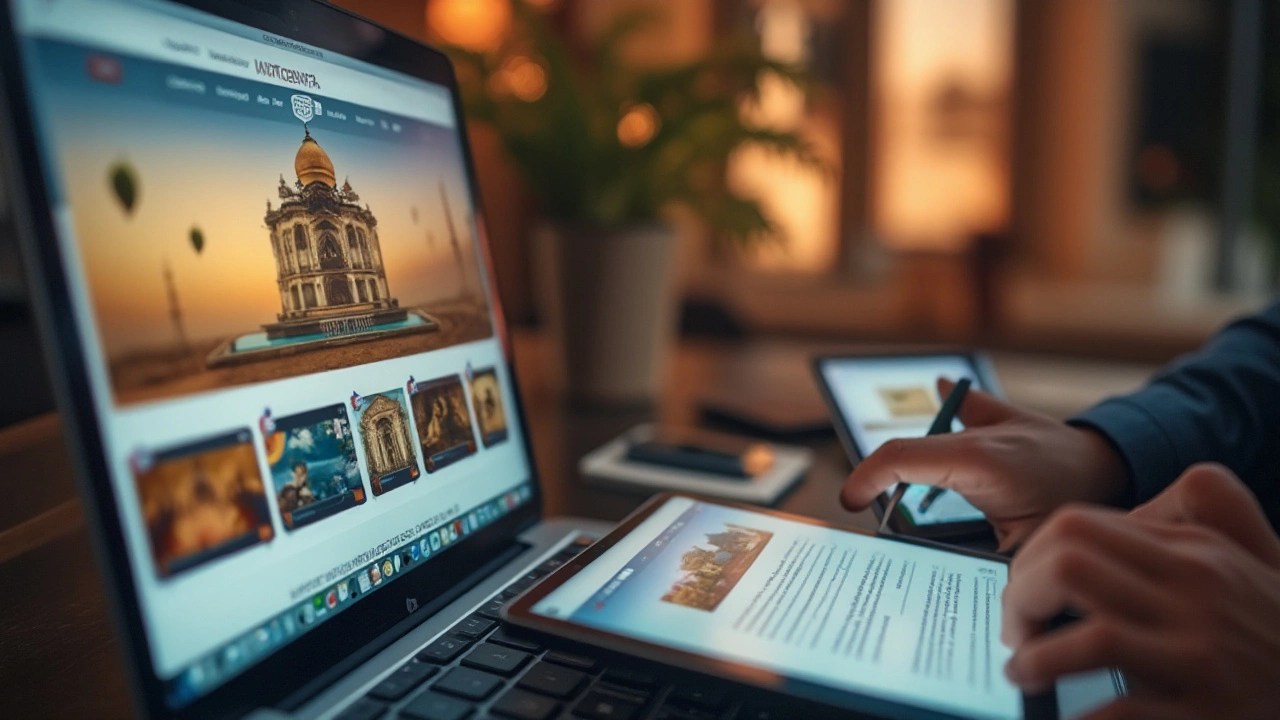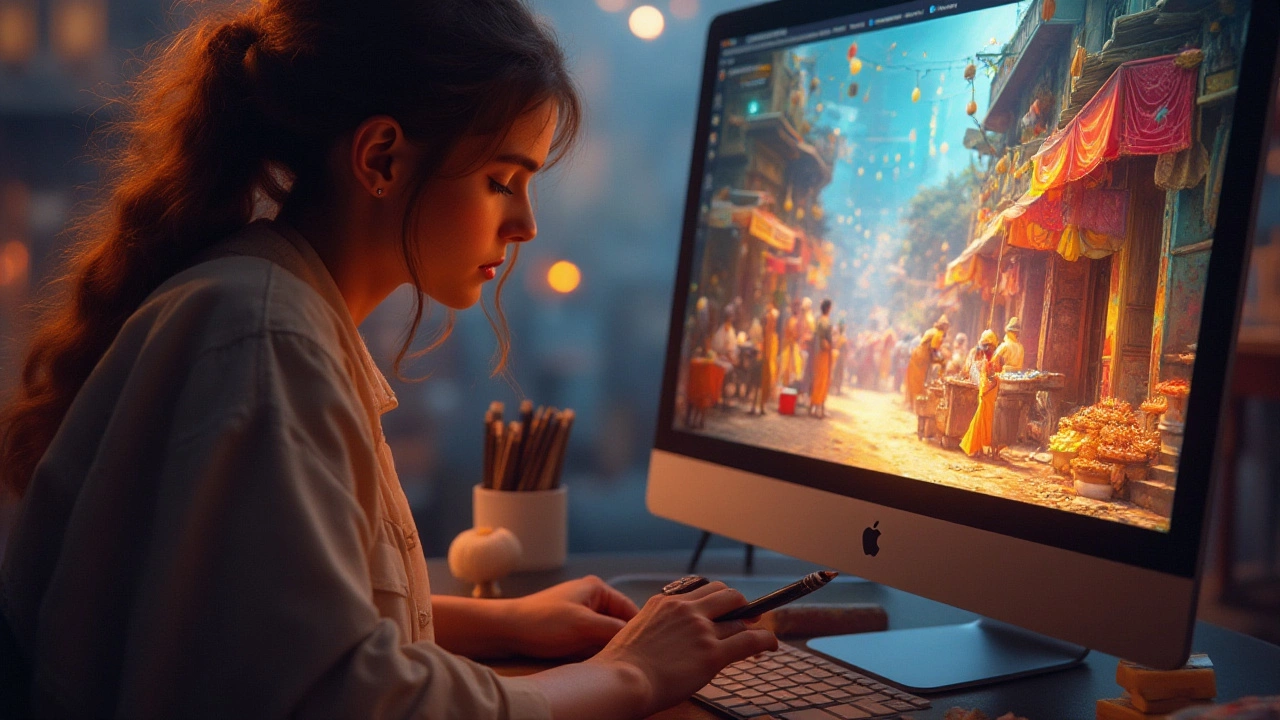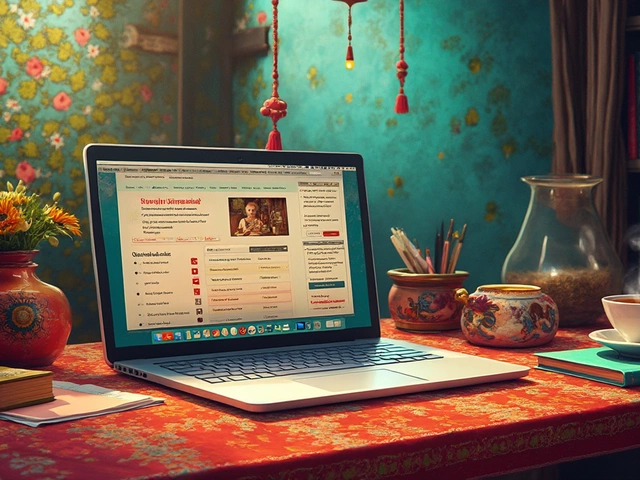Crafting a website that truly catches the eye involves much more than just a pretty layout. It's an art and science blend that centers on giving visitors a memorable experience. Every element, from the colors you choose to the fonts you use, plays a crucial role in drawing people in and making them stay.
In a world where attention spans are dwindling faster than summer days, standing out online is a challenge worth meeting head-on. Whether you're tweaking an existing site or building from the ground up, the principles of solid design can transform viewers into loyal visitors.
This piece will navigate through various design strategies that can turn an ordinary webpage into a captivating brainchild. It will provide insights into color psychology, typography choices, and user-centric navigation techniques while underscoring the importance of images and interactive elements in enriching the user's journey through your site.
- Choosing a Captivating Color Palette
- The Power of Typography and Fonts
- Enhancing User Experience through Navigation
- Impactful Imagery and Graphics
- Interactive Features to Wow Your Visitors
- Responsive Design for Mobile Users
Choosing a Captivating Color Palette
The first step in designing an eye-catching website is selecting a color palette that resonates with your brand and speaks to your target audience. Each color has its psychology, evoking specific emotions and reactions. For instance, blues often evoke trust and calm, which is why they're popular among banks and health-related sites. Meanwhile, reds can create excitement and passion, making them ideal for brands wanting to capture a youthful and dynamic image. Understanding these nuances can guide you in crafting a visual identity that sticks.
When choosing colors, it's crucial to think about how they work together. A harmonious color scheme can create balance and coherence across your site. The color wheel is an essential tool here, helping designers identify complementary, analogous, or triadic schemes that can be both aesthetically pleasing and functional. A common approach is to choose one dominant color and two accent colors, which can be used to delineate sections and highlight key information. For instance, a travel agency might use a warm orange as its main color, with cool blues and greens to highlight various sections.
Context matters too. The colors seen on a computer screen can look different when viewed on mobile devices due to varying screen technologies and resolutions. Testing your web design across multiple platforms ensures consistency. Additionally, accessibility should be at the forefront of your mind. Colors need to be chosen with sufficient contrast to ensure readability for users with visual impairments. Tools like the Web Content Accessibility Guidelines (WCAG) can help assess your site's accessibility in this regard. By prioritizing accessibility, you enhance user experience for all visitors.
Many renowned companies leverage colors strategically. Coca-Cola's red is globally recognized, creating a sense of passion and excitement, while Facebook uses blue to convey trust and reliability. Such consistent use of colors not only builds brand identity but also establishes an emotional connection with audiences. According to a study published in the Journal of Business Research, up to 90% of quick judgments about products can be based on color alone.
"The right mix of colors can directly influence a consumer's actions, especially when making a purchase decision," says Sally Augustin, an environmental psychologist.
Incorporate seasonal or trending colors to stay relevant, but always ensure they align with your core brand message. It's easy to get swept up in fads, but sticking to a well-thought-out palette rooted in your brand values ensures longevity. For instance, Pantone's Color of the Year can be a source of inspiration but should be used sparingly. Consider context, audience preferences, and regional differences to ensure your website's design ideas are both modern and timeless. This careful balance is key to maintaining an engaging and attractive online presence.
A practical way to test your color choices is to create a mood board. This visual compilation allows you to experiment with different combinations and assess how they align with the brand's identity. Digital tools like Adobe Color or Canva’s color palette generator can streamline this process, enabling you to visualize and tweak colors. Collaborating with stakeholders during this phase ensures the selection resonates with everyone involved, reducing costly revisions later on. Drafting a style guide can also help maintain color consistency across different content types.
The Power of Typography and Fonts
Typography is much more than just selecting a font for your website; it is the art and technique of arranging type to make written language legible, readable, and appealing when displayed. Typography's impact on web design is often underestimated, yet it forms the backbone of user experience. The right choice of font can evoke emotions, provide hierarchical differentiation, and guide users through content seamlessly. The harmony between typeface and the rest of the web elements must be carefully orchestrated, as the visual nuance of your site largely depends on this dance. Numerous studies indicate that a well-thought-out typographic scheme can increase information understanding by readers by as much as 20%. A striking example of the power of type is how fonts communicate brand personality. For instance, elegant serif fonts may conjure a sense of tradition and reliability, popular with institutions and luxury brands alike. In contrast, sans-serif fonts exude modernity and clarity, lending themselves well to tech-driven and forward-thinking companies.
Designers often have to walk a fine line between creativity and functionality. It is essential to ensure that the chosen typefaces not only align with the brand's ethos but also perform well across different screen sizes and resolutions. Adaptive typography, involving dynamic resizing and responsiveness to screen changes, ensures readability remains unhampered across all devices. Variable fonts are a solution currently gaining traction; they allow a single font file to behave in countless ways, providing designers with flexibility without increasing load time. Speaking of load times, it is crucial to remember that though numerous web fonts are available, not all should be employed. More fonts mean more data to load, potentially slowing down page deliveries and affecting user experience negatively. Striking a balance is key; typically, limiting to one or two primary fonts with variations in size and weight can achieve the right visual hierarchy.
“Design is not just what it looks like and feels like. Design is how it works.” — Steve Jobs
Moreover, accessibility must not be overlooked in the typography discussion. Fonts must not only be stylish but also inclusive. This means ensuring legibility across all possible user scenarios, including those with visual impairments. Techniques such as employing a contrast ratio that adheres to the Web Content Accessibility Guidelines (WCAG), and avoiding overly decorative fonts that are hard to decipher, are vital considerations. Additionally, spacing between letters and lines, known as kerning and leading respectively, should be adjusted to maximize readability, particularly in longer bodies of text. It is fascinating how typography can essentially control how users navigate a webpage, subtly emphasizing important content while guiding them effortlessly from one section to another.
It is undeniable that the stroke of typographic artistry is influential in crafting an enticing user interface. Attentive typographic decisions make information easier to process and layouts more harmonious. It's beyond aesthetics—it extends into psychology and human behavior. Typography shapes the way users feel on a subconscious level; thereby, when harnessed properly, it can ensure that a website's message is communicated most powerfully and effectively. Remember, your typography speaks before you even say a word—it’s the voice of your web design.

Enhancing User Experience through Navigation
When it comes to making a website truly engaging, few things are as crucial as intuitive navigation. It acts like a roadmap for your visitors, guiding them effortlessly from one corner of your site to another. Without it, even the most brilliantly designed web pages can become a frustrating maze. One key aspect of effective navigation is simplicity. According to a well-known principle called Hicks Law, the time it takes for a person to make a decision increases with the number and complexity of choices. This means that by presenting visitors with a simpler menu structure, you not only lessen cognitive load but also boost their satisfaction and engagement.
Beyond simplicity, consistency stands as another pillar of great navigation. Users should feel at home as they travel through your website, regardless of which page they're on. Consistent placement of menu items, along with a uniform style across all pages, helps achieve this seamless experience. It ensures that users don't have to relearn the layout every time they move to a different section of your site. Hence, the golden rule here is to keep the colors, fonts, and overall design elements uniform.
Types of Effective Navigation
Navigation can manifest in a variety of forms, each with its own benefits and ideal use cases. Let's start with horizontal navigation bars, which are the most common type found on the web. Placed at the top of the page, they give immediate access to main sections. Vertical navigation menus, on the other hand, are excellent for websites with numerous categories and links. They allow the main content to take center stage without overwhelming users with options. Think of sidebars which work particularly well for sites like blogs.
"Consistent, intuitive navigation reassures visitors and encourages them to explore your site more deeply," says Jakob Nielsen, a pioneer in web usability concepts.Breadcrumbs are another navigation technique, especially useful in content-heavy sites, as they allow users to trace back their steps without hassle. They’re typically displayed near the top, showing a trail from the home page to the current page.
Modern Approaches and Technologies
As the internet continues to evolve, so do navigation practices. Increasingly, websites are experimenting with dynamic, interactive navigation elements that respond to user behavior in real-time. For instance, predictive search bars and dropdown menus can anticipate user input, suggesting links or content based on past behavior or trending topics. Another modern approach is the use of hamburger menus, particularly in responsive design. These three-line icons tuck away the navigation menu, which can be tapped to reveal the full list of links. Simplifying user experience on mobile devices has become imperative with mobile web traffic consistently surpassing desktop visits. Speaking of statistics, as of 2023, mobile devices accounted for over 63% of global online traffic.
Each navigation strategy should aim to enhance and enrich the user experience, helping visitors reach their destination quickly while keeping the journey seamless and enjoyable. Investing in user testing can provide valuable insights into how visitors interact with your navigation and identify pain points that may need adjustment. By continually refining and optimizing your navigation, you can create a website that not only looks beautiful but also functions expertly, leaving a lasting impression on your visitors.
Impactful Imagery and Graphics
The magic of imagery in web design lies in its capacity to convey emotions, stories, and messages quicker and more powerfully than words ever could. Harnessing the power of impactful imagery can transform your website into an unforgettable visual journey. The choice of images directly affects the perception of your brand, making it essential to choose visuals that resonate with your audience's emotions and cultural references. High-quality images catch attention faster, ensuring visitors stay longer, boosting browsing times and potentially increasing conversions.
While selecting images, consider both relevance and cultural sensitivity. An effective image aligns with the content it accompanies, augmenting the narrative rather than distracting from it. It's worth noting that images should be optimized to maintain fast loading times, as delays could discourage visitors. Tools like Adobe Photoshop or online platforms like Canva can aid in adjusting resolution without compromising quality. In fact, according to Adobe, websites employing well-thought-out graphics see a 40% higher engagement rate. This is a testament to how graphics not only beautify a page but also enhance user experience.
“People remember only 10% of what they hear, 20% of what they read, but 80% of what they see.” - John Medina, Brain RulesCreating a narrative with images means choosing those that could potentially tell your brand story. Rather than mere fillers, images should embody the spirit of what your website represents. This can be achieved through original photography or curated stock photographs that align with your brand’s essence. Companies like Airbnb have set precedents by opting for authentic imagery that tells the unique tales of their community, creating deeper connections with their user base.
Including graphics goes beyond selecting static images — consider incorporating interactive graphics or animations to engage users further. These elements can guide users’ attention to key areas or actions on your site. Subtle animations can make interfaces feel more alive, though restraint is vital to avoid overwhelming or distracting. A study with TechSmith found that sites with thoughtful animations reported users being 70% happier and more willing to engage with interactive content.
Using Graphics to Communicate
Infographics are another worthwhile strategy. They allow you to present complex data sets, making information digestible and engaging. This approach is particularly effective for blogs or content-heavy websites. Given that the brain processes visuals 60,000 times faster than text, integrating graphics as illustrative tools empowers your website to communicate more efficiently. Anchor your visuals with accompanying text to guide understanding, ensuring they complement—rather than replace—your core message. Taking the time to craft customized infographics can also offer a distinct branding edge, setting your site apart from competitors who opt for generic stock options.To maximize the potential of imagery, incorporate alt text for accessibility, ensuring that users with disabilities, or those who rely on screen readers, can also have a rich experience. Good SEO practices recommend images be supported with descriptive alt text, contributing to better search engine indexing of your web design. Implementing this strategy is essential not only for inclusivity but also for expanding your site’s reach and discoverability. By prioritizing impactful imagery and graphics, your site becomes not only a feast for the eyes but a gateway to meaningful, curated experiences.

Interactive Features to Wow Your Visitors
Creating a website that speaks to the heart of its user isn't just about static design elements. It's about bringing in interactive features that invite engagement and enhance the online experience. Interactivity doesn't just make your site fun and engaging; it makes it memorable. At a time when digital content competes fiercely for attention, incorporating dynamic elements can be the difference between a fleeting glance and a lasting relationship.
One of the keys to using interactive features effectively is to ensure they serve a purpose beyond mere aesthetics. These features should encourage users to communicate, explore, and engage more deeply with your content. Think about including sliding galleries that allow users to navigate through images at their own pace or interactive infographics that unpack complex information in a visually appealing and digestible way. Not only do these elements catch the eye, but they also invite users to delve deeper into the wealth of information on your site.
It’s critical to tailor the interactivity based on your target audience’s expectations and your industry’s trends. For instance, if you’re in e-commerce, integrating an interactive product visualizer can give users a real-time look at customization options or product features they’re interested in. Quizzes and surveys are also fantastic tools to create a personalized experience while collecting valuable data on customer preferences. According to a report by Econsultancy, websites that incorporate personalized quizzes report significant increases in both engagement and conversion rates.
"Interactive content is up to 19% more effective at helping brands reach their content marketing goals compared to static content," states a study by Content Marketing Institute.
To incorporate interactive features seamlessly, consider starting with a few key elements and then expanding based on user feedback. Animation is one such feature that can add a layer of sophistication and dynamism to your site. Used sparingly, animations can provide subtle cues to guide users around your site’s architecture or highlight key points of interaction, like call-to-action buttons. Remember, every piece of interactivity should be purposeful, aiding users in navigating your content intuitively.
Interactive design is not a one-size-fits-all solution. It should evolve with your brand and adapt to the changing needs of your users. Keep testing and garnering feedback to ensure that your interactive features are improving user experience rather than complicating it. Tools like A/B testing can help refine these elements, allowing you to see what resonates with your visitors most.
Finally, don't forget accessibility as you design these features. Use clear tags, provide text alternatives, and ensure that all users, regardless of their abilities or devices, can enjoy the full suite of interactions your site offers. Incorporating interactivity with inclusivity in mind can widen your reach and foster a more welcoming online environment.
Responsive Design for Mobile Users
As the digital landscape evolves, more people are accessing the web through their mobile devices than ever before. In fact, data from Statista reveals that over half of the global website traffic is generated from smartphones. This shift necessitates that websites not only look appealing but also function flawlessly across a variety of devices, especially mobile phones. This is where responsive design becomes indispensable, ensuring that every user enjoys an engaging web experience regardless of their screen size. Responsive web design involves creating web pages that automatically adjust their layout to fit the device's screen. This means elements like text, images, and buttons resize fluidly, maintaining both ease of navigation and aesthetic appeal. For instance, if a website looks stunning on a desktop, it shouldn’t lose any charm or functionality when viewed on a smartphone or tablet.
One fundamental principle of creating a responsive website is the use of flexible grids and layouts. Instead of relying on fixed units like pixels, designers use relative units such as percentages to size elements. This allows content to realign itself proportionately when the device alters its orientation or window size, maintaining a cohesive and seamless look. A popular framework like Bootstrap often comes into play here, simplifying the process with its pre-designed grid system. Furthermore, while discussing the essence of responsive design, it’s essential to consider touch screen compatibility. For mobile users, this means making sure that links and buttons are not only tappable with ease but also correctly spaced apart—thus avoiding accidental clicks. Smashing Magazine rightly points out that responsive design is more about usability and aesthetics; it's about 'crafting a quality experience irrespective of the device in use.'
"Responsive design is not just a feature, it’s an essential part of the web design process. It’s the non-negotiable baseline.” – Brad Frost, Web Strategist and Designer
Additionally, images play a crucial role in maintaining the site's visual appeal and they too must be responsive. This involves implementing techniques like adaptive image serving, where different image sizes are provided for different devices. On another note, optimizing images to ensure fast loading times without losing quality is equally important. Not only does this enhance the visual aspect, but it significantly impacts the user's patience and the overall performance of the site. Google's research indicates that over 50% of users abandon a page if it takes longer than three seconds to load. Thus, balancing the quality and size of images is a critical task for responsive sites.
Another key component in responsive design is the use of CSS media queries. These queries enable developers to apply different styles depending on the screen size or the orientation of the device. This could mean swapping a horizontal navigation bar into a collapsible vertical menu or changing font sizes to increase readability on smaller screens. This adaptability ensures that mobile users don’t miss out on interactive features that might be present in the desktop version of the website. Moreover, adopting a 'mobile-first' approach in design has gained significant traction. This means designing for the smallest screen first and then scaling up, ensuring that your site maintains its core functionalities and visual integrity across all devices.
| Device | Percentage of Global Traffic |
|---|---|
| Mobile | 54.8% |
| Desktop | 42.7% |
| Tablet | 2.5% |
In summary, incorporating responsive design techniques is not merely a trend but a necessity in today’s digital age. With the continued rise in mobile usage, ensuring your web design adapts seamlessly to any screen size enhances user engagement and opens your website to a broader audience. Embracing technologies and frameworks that support this adaptability will position your site favorably, meeting both current user expectations and laying groundwork for future advancements in web technology. Always remember, a site that’s not responsive might not get that second chance with users browsing on their smartphones.



